-
Par fiberopticalcom le 31 Janvier 2017 à 10:14
At present, the Ethernet patch cable can be simply divided into shielded Ethernet cable and unshielded Ethernet cable, both of which have their features and advantages. Considering that, is there any difficulty for you to decide which one should be selected for deploying your network? Are you familiar with the two kinds of Ethernet patch cables? Is there any advantage of the shielded Ethernet cable, compare to the traditional unshielded one? In fact, using the shielded Ethernet cable allows for a better performance of your network, especially in the application with high EMI, which will be mainly introduced in the following text.
What Is the Shielded Ethernet Cable?
Shielded Ethernet cable is an enhanced version of unshielded Ethernet cable, which features a shield inside usually made up of copper tape, a layer of conducting polymer or a copper or aluminum braid, with the aim of reducing the EMI (Electromagnetic Interference). Generally, there are several kinds of shielding like braided shield, screening and foil to be applied for each pair in the cable and all pairs together, which makes various shielded Ethernet cables available on the market and popularly used among users, for instance, STP (shielded twisted pair), SSTP (screened shielded twisted pair) and FTP (foil twisted pair) cables. To better know the internal structure of the shielded Ethernet cable, you can learn it from the following figure.
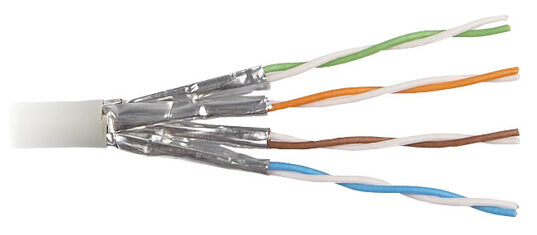
Why Shielded Ethernet Cable Is Used?
It is well known that EMI, also referred to as FRI (radio frequency interference), can be produced by an external source affecting an electrical circuit by electrostatic coupling, electromagnetic induction, or conduction when the data is transmitted in our network. If the EMI is very high in your network, the data transmission errors may occur. Then how to ensure your network performance?
In general, the external source can be made by natural sources like sun and thunder storms or man-made sources like vehicle ignition systems and cell phones, which would exist in our everyday life and cannot be avoided. Taking this into account, we can only turn to other solution to directly reduce or avoid the EMI for ensure the transmission quality of our network. At first, the Ethernet cable with unshielded feature is designed with twisted pairs inside the cable to reduce the EMI, which performs not very good and doesn’t meet our expectation. Fortunately, experts soon put forward another method to resolve the issue—the shielded Ethernet cable, as one of the most used solution to protect our network from EMI.
What Are the Differences Between Shielded and Unshielded Ethernet Cable?
First and foremost, the shielded Ethernet cable performs better than the unshielded Ethernet cable in reducing the EMI, which greatly ensures the the data transmission quality of the devices most commonly used in buildings, such as microwave equipment, HVAC (Heating Ventilation Air Conditioning) systems and radio transmitters. It also has the ability to decrease the interference generated from devices like power tools and vacuum cleaners. Moreover, using the shielded Ethernet cable can prevent the signals from passing through the outer coating and entering nearby wires by accident for its special shielded structure, hence the crosstalk in the network can be reduced or even avoided.
In contrast to the unshielded Ethernet cable, there are also some disadvantages for the shielded Ethernet cable that should be paid attention to when choosing the Ethernet patch cable. Firstly, choosing the shielded Ethernet cable to deploy your network will cost higher than the unshielded one. Because both the manufacturing cost of itself and its related device for network deployment are more expensive than that of the unshielded one. Secondly, due to its complicate, shielded feature, you should pay more time and money for the installation and maintenance. And it would be difficult to restored if it is damaged because the shielding is quite fragile and rigid. Thirdly, the shielded Ethernet cable is more thicker that makes itself not so flexible as the unshielded one. If you should deploy the network in narrow space, the shielded Ethernet cable has no advantage over the unshielded one.
Conclusion
The shielded Ethernet cable is really a cost effective solution for the applications where the EMI is very high, which can greatly improve your network performance and extend the life span of your equipment. Although it costs much higher than the unshielded one, is more difficult to install and maintain, and is not so flexible, it can perform better to reduce the EMI when put into use. Beside, the unshielded Ethernet cable is still recommended for you if the EMI around your network is not a risk.
 votre commentaire
votre commentaire
-
Par fiberopticalcom le 27 Janvier 2017 à 10:08
Can Cat 5e Work with Cat 6 Patch Panel or Cat 6 Work with Cat 5e Patch Panel?
There is no doubt that the Cat 5e patch panel always works with the Cat 5e cable, while the Cat 6 patch panel is specially designed to manage the Cat 6 cable for a neat, secure and well organized network. However, have you ever met the condition that the old Cat 5e cable should be work with the new Cat 6 patch panel or the old Cat 5e patch panel should be used to manage the new Cat 6 cable because you only changed one of the two devices into a new one? Did they still perform well? Not any compatible issue? Or work badly for the mismatching problem? The following will discuss about the differences between Cat 5e and Cat 6 cable, and the differences between Cat 5e and Cat 6 patch panel, then explore these two mismatching cases for the answers.
Differences Between Cat 5e and Cat 6 Cable
Firstly, as the Cat 6 cable consists of 23 AWG copper conductors but Cat 5e cable is made up of 24 AWG copper conductors, the diameter of Cat 5e cable is smaller than that of Cat 6 cable. Meanwhile, there is the spline between each pair of wires in Cat 6 cable that separates one pair of wires from one another, as shown in the figure below. All these two factors make the Cat 5e cable thinner than Cat 6 cable. Besides, Cat 5e cable is specially applied in 100Base-T and 1000Base-T network, while Cat 6 cable is more suitable for 1000Base-T network and supports the 10GBase-T network at lengths up to 37 meters. Hence, if the data transmission speed in your network is very low, there should be no difference in performance between Cat 5e and Cat 6 cable. But if high speed is required, which one to be chosen should depend on the network demand.
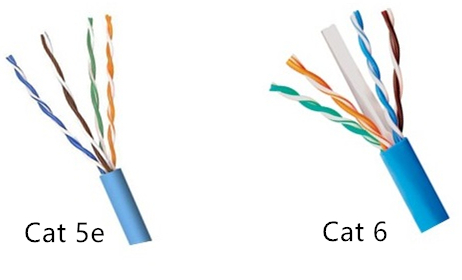
Differences Between Cat 5e and Cat 6 Patch Panel
Since there is a difference in the wire gauge specified between Cat5e and Cat6 cable, their corresponding patch panels are different accordingly, which should be paid attention to in the mismatching cases. What’s more, the data transmission speed is also different, because the Cat 5e patch panel always works in Fast Ethernet network and the Cat 6 patch panel is highly recommendable to support the Gigabit Ethernet network.
Using Cat 5e Cable with Cat 6 Patch Panel
As mentioned above, the Cat 5e cable is thinner than the Cat 6 cable. As a result, when we use Cat 5e cable with the Cat 6 patch panel, can it perform well? Will it be too loose? If you make a experiment, you’ll find that it can work normally in this case. Why? Although the Cat 6 individual twisted pairs insulated is usually thicker than Cat 5e, this is usually not a problem with termination, but with how many cables you can stuff through a piece of conduit. Hence, Cat 5e cable can work normally on the Cat 6 patch panel but may be a loose connection. What should be noted is the network performance. Since Cat 5e cable works with Cat 6 patch panel in this case, the performance of the network can only reach the maximum performance of Cat 5e cable.
Using Cat 6 Cable with Cat 5e Patch Panel
Except for the case we have already discuss, you may also encounter with the case that the Cat 6 cable should work with the Cat 5e patch panel. Although the diameter of the Cat 6 cable is larger than that of Cat 5e cable, it is still able to work without effect on the performance of the cable and patch panel if you use the Cat 6 cable with Cat 5e patch panel. As for the network performance, the fact is that the Cat 6 cable is backward compatible with Cat 5e feature. Hence, there is no need to worry for using the Cat 6 cable with the Cat 5e patch panel. But you are still suggested to upgrade your patch panel to a Cat 6 type, just in case.
Conclusion
From this paper, it is easy to learn that both the Cat 5e cable can work with the Cat 6 patch panel and the Cat 6 can work with the Cat 5e patch panel. However, both are not recommended for the following reasons. If you are in the first case, then you are suggested to use a Cat 5e patch panel to manage the Cat 5e cable, which is less expensive can performs better than the Cat 6 patch panel. Meanwhile, in the second case, when punching down the Cat 6 cable on a Cat5e panel, the larger wire may end up bending or even breaking.
 votre commentaire
votre commentaire
-
Par fiberopticalcom le 24 Janvier 2017 à 08:34
With the complication of your network, do you have the trouble that the patch cables deployed in your network are always in a mess? If yes, you are suggested to use the patch panel for better cabling management. Since the copper patch panel can be available at a less expensive cost than fiber patch panel but can also perform well in managing the cables in your network, it is a good choice for you to choose copper patch panel for deploying a neat, fast and secure network.
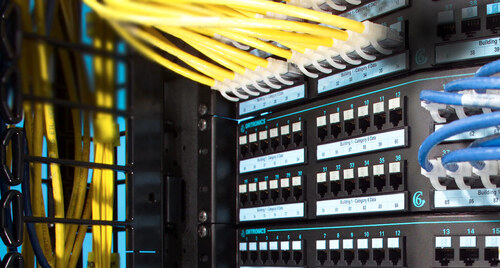
At present, there are three commonly used types of copper patch panels designed with different aims, Cat 5e, Cat 6 and Cat 6a patch panel, both of which have their own features and advantages. To better know these three kinds of copper patch panels, the following will mainly introduce their basic information, which may help you select one of the most suitable patch panel for deploying your network.
What Is the Cat 5e Patch Panel?
Cat 5e patch panel, always used for Fast Ethernet network, is made up of steel materials that is compliant with TIA/EIA 568 industry specification. For the advantage of steel materials, it can work well even in the most extreme conditions. Meanwhile, it is equipped with individual, fully modular printed circuit boards (PCBs) and a rear cable manager. In general, the Cat 5e patch panel is designed with 6-port and 8-port module grouping that may have 8, 12, 24 or 48 ports totally. With this high density design, it has the ability to greatly save the valuable rack space, maximize the performance of your network and keep up with the growing changes of your network.
What Is the Cat 6 Patch Panel?
To face the increasing demand of the network, Cat 6 patch panel is specially designed for 1 Gigabit Ethernet network, which has already meet or even exceeded the TIA/EIA 568 industry specification. As for its wiring configurations, the Cat 6 patch panel can be provided with both T-568A and T-568B wiring scheme on the market. Furthermore, it is always terminated with the standard 110 termination tools on the rear, allowing for quick installation. In contrast with Cat 5e patch panel, it can be also configured with 6-port or 8-port modules, but available with more ports, such as, 12, 24, 48, and 96 ports. All in all, this kind of patch panel supports easier cabling management and saves more data center rack space.
What Is the Cat 6a Patch Panel?
CAT6a patch panel is an advanced kind of copper patch panel, published with the aim of meeting the requirements of 10 Gigabit Ethernet network. For this purpose, it offers usable bandwidth beyond 250MHz and exceeds the TIA/EIA-568-B.2-1 component, the permanent link and the channel level performance specifications. What should be noted is that it also can be backward compatible with lower level cabling systems. Compared with the previous two kinds of copper patch panel, this one has the enhanced front and rear labeling features for easy circuit identification. In addition, T568A and T568B wiring configurations are also available for this kind patch panel, which can be easily recognized by the color-coded wiring label.
Nowadays, there are various kinds of CAT6a patch panels with different amounts of ports, varying from 12 to 96 ports. Among these kinds of CAT6a patch panels, the patch panels with 24- and 48-port are very popular that provides the maximum strength and durability and eliminates panel flex during termination. Besides, there are port labeling areas and port numbering in these kinds of patch panels, which makes the circuit identification easier.
Conclusion
From this paper, it is easy to conclude that the Cat 5e patch panel is specially designed for Fast Ethernet network, while the Cat 6 patch panel is more suitable for 1 Gigabit Ethernet network. If you want to upgrade your network to 10 Gigabit Ethernet network, then the CAT6a patch panel must be a good choice for you. For better cabling management, choosing the most suitable patch panel is really important that can help you deploy a neat, fast and secure network and greatly ensure the performance of your network.
 votre commentaire
votre commentaire
-
Par fiberopticalcom le 20 Janvier 2017 à 07:35
Although the wireless network becomes more and more popular for its convenience, most of our home still deploy wired connections with copper based devices that can work faster and more stable. Every so often, we get questions from people who plan to deploy copper based networks in their homes. The most frequent question we get is, "how to fast build a copper network at home?" Considering that, the following will give detailed instructions for building a copper home network in a very fast and smooth manner.
Step by Step Instructions
As the copper based network has an important place in the our daily life, it is very necessary to know the steps for deploying our own copper based network that is much easier than that of the fiber based network. Of course, before deploying, you should consider your requirements for the copper based network, such as, easier access to broadband and WiFi, higher network performance. Then let’s study the step by step instructions for building a copper network at home.
Bringing the Service Provider Distribution Cable to Your Home
Nowadays, the distribution point of copper network cable or fiber optic cable is always installed inside or near the building by the broadband service provider, offering service for each house of the building. In some old buildings, the cables between the end users and distribution point are still copper based, while fiber optic based cables are usually used in the new buildings. If you are living in a new building with fiber optic based distribution point, then you need a ONU (Optical Network Unit) for converting the optical signals into electrical signals and distribute the signals to different ports and home devices. Hence, the service provider distribution cable can be brought to your home. At present, there are various ONUs and routers available on the market, supporting WiFi and satisfying various port requirements. If your home is not very big, you just need to choose one ONU or router for your home network.
Wiring the Whole Connection for Your Home
After introducing the service provider distribution cable to your home, you should decide how many ports your home network requires and how many devices should be connected to the network, which is very important for owning a home wired network with great broadband access. Due to the good preparation, you can do the whole home wiring smoothly without any delay. The following figure shows an example of the whole home wiring that connects the bedroom, living room, office and dining room of this house to the network for your reference.
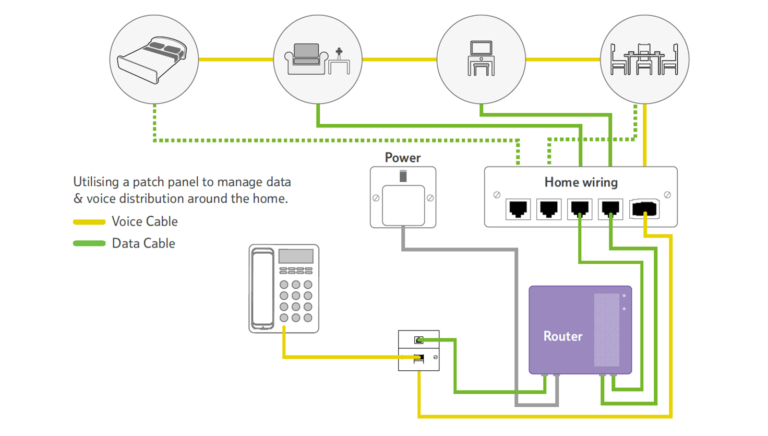
From the figure above, you can learn that there are several kinds of devices, such as, televisions and telephone, connected to the home wired network for better and smarter performance, which is also know as smart home. For instance, the voice cable is used for connecting the telephone to the network, so that the phone calls would be not missed by the house owner. Besides, other devices like air condition, light control device can be also connected to the home wired network for living in a smart home.
As for the types of the copper cables used for the connections between the network and the home devices, the Cat 5e and Cat 6 Ethernet cable are most commonly used copper based patch cables at present that completely satisfy the requirements of your network. However, the Cat 6a and Cat 7 Ethernet cable are more recommendable with higher performance which are capable of meeting the requirements for both now and future.
Terminating the Copper Cables and Finishing the Whole Deployment
The third step is to terminate the copper cables that used for the whole connection, which plays an important role in deploying a secure and reliable wired home network. In general, the copper patch cable is suggested to be terminated at the wall plate port and a length of RJ45 copper network patch cable should be used for connecting the port with target device, thereby the whole deployment of home network can be finished.
Conclusion
This paper mainly studies the process of how to fast build a copper network at home, which is very useful for people who plan to deploy a copper home network for better performance. In strict accordance with the step by step instructions, you can easily and fast deploy your wired home network. Except that, choosing the most suitable patch cable also can’t be ignored for good broadband access. You can choose one of the most suitable patch cable from the mentioned above Cat 5e, Cat 6, Cat 6a and Cat 7 Ethernet cable to meet the requirements of your network.
 votre commentaire
votre commentaire
-
Par fiberopticalcom le 18 Janvier 2017 à 09:32
With the rapid development of the network technology, the network deployment becomes much more complicated than ever before to satisfy the increasing network needs. In order to deploy the the complicated cabling network in a tidy, fast and correct manner, the patch panel is designed to better manage the patch cables in the network, which can be divided into two types, the copper patch panel and the fiber patch panel. To avoid the connection errors and making the cabling network flexible, reliable and neat, this paper will mainly introduce some commonly used types of the copper patch panel that may be helpful for you to pick the most suitable one for your cabling network.
Commonly Used Types of Copper Patch Panels
While the copper patch panel has made a great contribution to the complicated cabling network as a cost effective solution, the type of the copper patch panel has become more and more diversified, such as, shielded and unshielded patch panel, flat and angled patch panel, common and high density patch panel, classified according to the designed aspect. The following will discuss the details of these four types of commonly used copper patch panels.
Shielded vs. Unshielded Patch Panel
Since the performances of the shielded and unshielded patch panel are different from each other, you should consider that should the patch panel be shielded or unshielded to fit your network before ordering the copper patch panel. Besides, you may also wonder that can you use the shielded patch cable with an unshielded patch panel or the unshielded patch cable with a shielded patch panel? Let’s explore these questions and seek the answers.
There is no doubt that the shielded patch panel performs higher than the unshielded one, because the shielded feature enhances the anti-interference performance of the copper patch panel and protects the high speed network from noise and EMI (Electro Magnetic Interference). Considering that the interference is really a risk for the network that may cause transmission errors or failures, the unshielded patch panel is designed for the common applications where the EMI is not very high, while the shielded patch panel is more suitable to be used in the environments with high EMI. Besides, you can also select the patch panel according to the network speed. Moreover, if your network is a 1G Ethernet network, then both the shielded and unshielded patch panel can be chosen. But if the network is a 10G Ethernet network, then you are highly suggested to choose the shielded one. For better know the two types of patch panels, here offers a figure that shows the structural difference between the Cat6 shielded patch panel and the Cat6 unshielded patch panel.
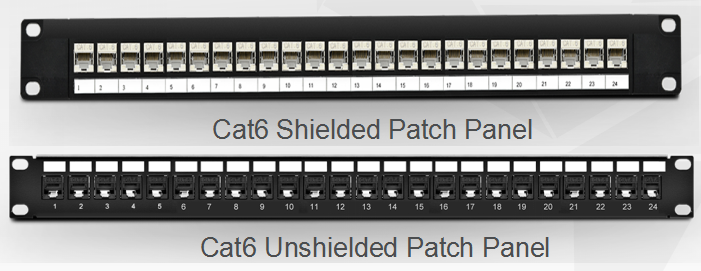
Can you use the shielded patch cable with an unshielded patch panel? It relies on the network environment. In simple words, if there are no high power electrical wires in the network, then you can use the unshielded patch panel. But if arc welders, high power radio transmitters or other high power electrical equipment near the network, you should better go with the shielded patch panel. As for using the unshielded patch cable with an shielded patch panel, it is OK in theory but unnecessary in practice. Because the shielded patch panel is much expensive than the unshielded patch panel.
Flat vs. Angled Patch Panel
On the basis of the appearance design, the copper patch panel can be classified into flat and angled patch panel, as shown in the following figure. The flat patch panel enables the horizontal cabling and routes the cables into vertical cabling, while the angled patch panel makes the cable termination easy and patch cord routing improved. Compared with the former one, the angled design of the latter one increases the rack density, managing high-density applications in one-fourth the area needed for conventional cable management systems. But taking the front depth requirements of the angled patch panel into account, the angled patch panel is not so good for the cabinet installation as the flat patch panel.
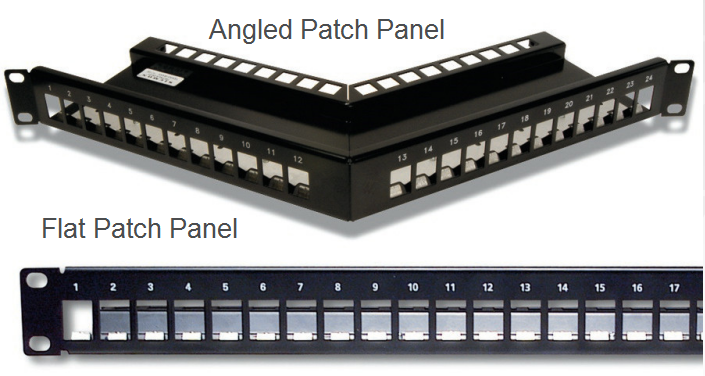
Common vs. High Density Patch Panel
As there are often 8 or 12-port configurations on the common patch panel, the high density patch panel is usually designed with 24 or 48 ports as an ideal solution for the applications where there is limited space. Since there are much more ports in the high density patch panel to connect and manage the incoming and outgoing Ethernet cables, it has the ability to conserve the rack space. Hence, if the space is limited in your network, then you can choose the high density patch panel to deploy your network cabling.
Conclusion
After discussion, it can be concluded that the unshielded patch panel is suitable for the applications where the EMI is not very high, while the shielded patch panel is more commonly used in the environments with high EMI. It can be also concluded that the flat patch panel is a good choice if you want to easily deploy the patch panel. Otherwise, the angled patch panel is highly suggested. Besides, if there is limited space in your network, you are recommendable to choose the high density patch panel rather than the common one for conserving space. For easier network deployment and better cabling management, you’d better pick the most suitable patch panel for your cabling network.
 votre commentaire
votre commentaire Suivre le flux RSS des articles de cette rubrique
Suivre le flux RSS des articles de cette rubrique Suivre le flux RSS des commentaires de cette rubrique
Suivre le flux RSS des commentaires de cette rubrique




